Yaesu FL-110 modification for 5W drive
![]() 7-sep-2017 Schematic redrawn.
7-sep-2017 Schematic redrawn.
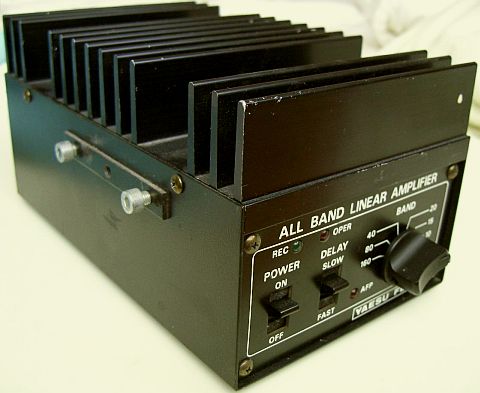
YAESU FL-110
REDRAWN FL-110 SCHEMATIC
Over the years, FL-110 schematics have become a rarity and what's on the Internet are mostly vage images. That's why they were collected and after a few nights of hard work to decipher value and numbering of the components, a good readable design could be drawn.

Corrections and additions are not excluded.
DESCRIPTION FL-110
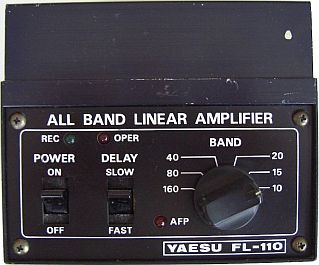
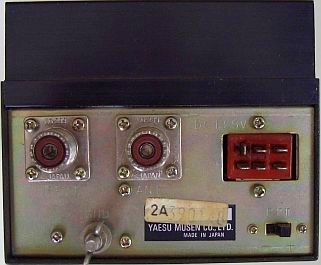
This pre-WARC 10 - 160 m band solid state all-mode linear power amplifier with low-pass filtering on six bands was produced for the Yaesu FT7 and FT310S/SD QRP transceivers. It operates on the 160, 80, 40, 30, 20, 17, 15, 12 and 10 meter amateur bands. Drive power is 15 watts CW/SSB, 4 watts AM/RTTY. Maximum input power of the finals is 200 W SSB/CW, 75 Ws RTTY and 50 W AM. The front panel has a DELAY switch to select FAST 0.1-0.2 seconds or SLOW 0.3-1.0 seconds to control carrier operated change over time. The rear panel has 50 ohm SO239 input and output jacks. This (120x100x200mm, 2.5 kg) device requires 13.5 VDC at about 17 A.

With this modification («fig) your QRP rig (FT-817 etc.) will put out the amplifier's rated 100 W. It will work into a 1 : 1.4 VSWR (SWR ≤ 1.5) when resistors of the input attenuator are removed and replaced. In addition it will allow 5 W drive to full output. It does work on the WARC bands with slight decrease in output power due to the low-pass filtering in the unit.
TEST WITH UNMODIFIED FL-110 (5 W drive and 13.8 VDC)
|
13.8 VDC |
160 m |
80 m |
40 m |
30 m (20m LPF) |
20 m |
17 m (15m LPF) |
15 m |
12m (10 m LPF) |
10 m |
|
Output |
60 W |
70 W |
80 W |
105 W |
105 W |
60 W |
80 W |
60 W |
55 W |
G4EDG's ADVICE
I completed the mod suggested by Frits, PA0FRI and indeed the power required to drive the FL-110 to 100 W output is now in the region of 5 W.
Just a word of warning when uses this amplifier with a FT-817. Used in the RF detection change over mode, this set-up lasted about 5 min before the '817 PA module blew!
I guess the change over time of the amplifier relay was enough to leave the '817 output unterminated, and with no effective high SWR protection in the 817, caused the PA to fail.
This is in no way due to PA0FRI's mod, but would suggest using hard switching from the 817 accessory connector to provide T/R switching for the amp.
73 Steve G4EDG
RELAY STEP-UP OR SPEED-UP FOR DECREASING PULL-IN TIME
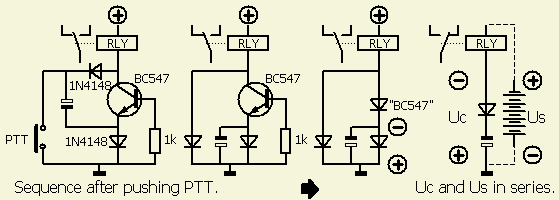 This in many magazines published simple design for increasing the relay pull-in time is often overlooked. This circuit works by using a short burst of a double supply voltage to move the contacts and then applies the original volts to the relay to lock the contacts in place.
This in many magazines published simple design for increasing the relay pull-in time is often overlooked. This circuit works by using a short burst of a double supply voltage to move the contacts and then applies the original volts to the relay to lock the contacts in place.
On receive the capacitor is charged to the supply voltage through both diodes. When switch (PTT) is pushed, the transistor turns on through 1 kΩ by the charged capacitor. Then the relay momentarily is supplied with about twice its voltage and closes faster than normal without harming the coil.
As soon as the capacitor discharges, the relay coil sees a normal supply voltage.
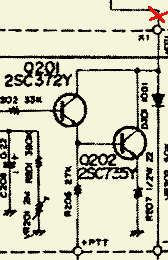
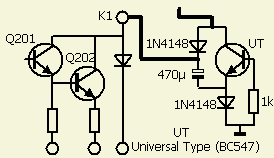 When the LPF PCB is folded up, on the lower print one see a red-white wire from an upright pin to the relay. The wire is disconnected and solder to the relay accelerator. Then, according to the diagram (fig»), connect junction point of elco and diode to pin; further connected circuit to ground.
When the LPF PCB is folded up, on the lower print one see a red-white wire from an upright pin to the relay. The wire is disconnected and solder to the relay accelerator. Then, according to the diagram (fig»), connect junction point of elco and diode to pin; further connected circuit to ground.
In summary, the relay accelerator is connected to:
1. the loosened red-white wire to the relay
2. the pin
3. mass
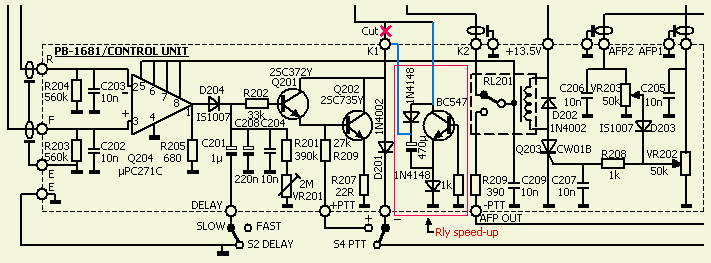 This shows how K1 is used as central point for the installation. In the right image I used a SD355 transistor as universal type, but you can use a BC547. |
 |
CONTINUATION
The previously implemented modification of the amplifier applies to the FL-110 at that time available to me. Meanwhile, it has been turned out that schematic and assembly of a FL-110 have undergone factory changes. An example of this is shown in the following image, but it is not excluded that there are more changes in circulation.
MODIFICATION FOR FLEX-1500
Decades ago I purchased my 2ndhand's FL-110 as spare, tested once for good operation and then no longer used. That changed when a FLEX-1500 came into my possession. Because this SDR transceiver delivers only about 5 W ouput, the PA appeared to be suited as amplifier.
It turns out that the corresponding circuit in my unmodified FL-110 differs from the downloaded Instruction Manual FL-110.
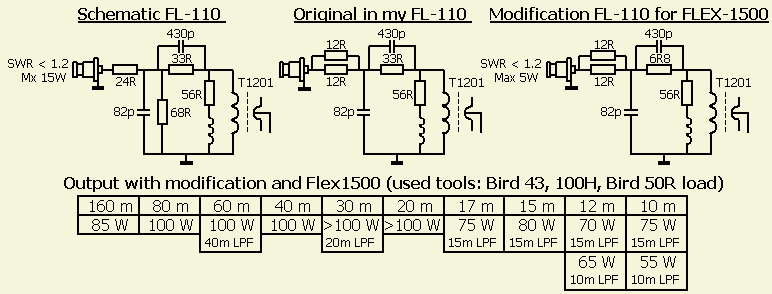
After some experimentation, a suitable update was found by replacing the original 33 Ohm resistance with a 6.8 Ohm induction-free type. The obtained ouput with control from a FLEX-1500 is shown in the table. For the WARC segments LPFs of the next higher bands are used. Remarkable is that maximum output on 12 and 10 m were obtained with the 15 m band low-pass filter (LPF).
See also FL-110 Manual, FLEX-1500 & FL-110
![]()